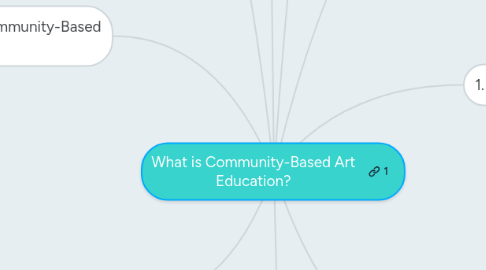
1. 5. Community-Based Art in Public Arenas
1.1. Rick Lowe
1.1.1. Creator of Project Row Houses in Houston, TX
1.1.1.1. The program saved 22 houses that were set to be demolished
1.1.1.1.1. Restored the houses as well
1.2. John Yancey
1.2.1. American Artist, Chicago
1.2.2. Known for murals
1.2.2.1. Constructed the largest freestanding pieces of public art of East Austin
1.2.2.1.1. Reflected on the lives' of past individulas in the Community.
1.3. development, corrections, education, intergenerational, aging, envrionment, healthcare, technology, politics, disability, conflict resolution, regeneration, culture, etc.
2. 6. Implications of Community-Based Art Education
2.1. Teachers should use the strengths of their students to plan community-based art projects
2.2. Ethnographic studies may be easily planned in after school programs
2.2.1. Internet information interviewing
2.2.2. Photography
2.2.3. Learning about culture in their communities
2.3. Outreach
2.3.1. Volunteering
2.3.1.1. The Learn and Serve Program
2.3.1.1.1. Funds/Rewards schools that promote community service
2.4. Designing artworks and art projects that have a social impact
2.4.1. Students will begin to see issues and concerns in their own communities
2.4.1.1. Explore ways to fix issues or promote awareness of it
2.4.1.2. Causes students to create personal connections with the community through their art
2.4.1.3. These ideas go beyond what may typically be explored in a normal class setting
3. 4. Ethnography within Community-Based Art Education
3.1. Encourages teachers and students to go out and actively consider environments in which they live
3.1.1. Traditions
3.1.1.1. Cultural heritages
3.1.1.1.1. Common interests
3.2. Considers relationship of community and culture
3.2.1. Seeks to bridge gap between theory and practice
4. Conclusion
4.1. Variety of definitions and opportunities, clarification of these means:
4.1.1. envision meaningful projects
4.1.2. enriching current education
4.1.3. enriching the lives of participants
4.1.4. Adding a sense of community to participants lives'.
5. 3. Outreach Programs for Community-Based Art
5.1. Create supportive art environment
5.2. Promote values and strengths of formal art education
5.2.1. Bridges gap between art understandings of different communities
5.2.1.1. Those who have been educated in art can help to awaken the artistic sensibilities of others
5.3. Empowers individuals by supporting personal artistic endeavors
5.4. Have a variety of functions including empowerment and promotion
5.4.1. From museum programs to individual artists working with the community
6. 1. Informal Teaching
6.1. Out of school learning - dominant art learning method
6.1.1. Methods include
6.1.1.1. apprentiship
6.1.1.2. folk art techniques/stories passed down through generations
6.1.1.3. taught at home
6.1.1.4. tutors
6.1.1.5. foreign travel
6.1.1.6. museums
6.1.1.7. visual media
7. 2. Organized Community Teaching
7.1. Who does it serve?
7.1.1. Local citizens
7.1.2. At-risk Youth
7.1.3. Homeless Individuals
7.1.4. older adults
7.1.5. Handicapped individuals
7.1.6. The incarcerated
7.1.7. Others
7.2. Examples of Organized Community Teaching
7.2.1. Community based programs
7.2.1.1. Tucson Arts Brigade
7.2.2. Craft Schools
7.2.2.1. Penland School of Arts and Crafts
7.2.3. Museum schools
7.2.3.1. Tucson Museum of Art
8. Introduction
8.1. When to contemplate Community Based Art Education?
8.1.1. When deciding how others can support/reform art programs.
8.1.2. When administrators want to increase enrollment
8.1.3. When elimination of art programs are being considered
8.1.4. To get students involved outside of the classroom
8.1.5. When using art to understand/support Social Justice issues.
8.2. What aspects should be considered in this contemplation
8.2.1. Rationales
8.2.2. goals
8.2.3. definitions
